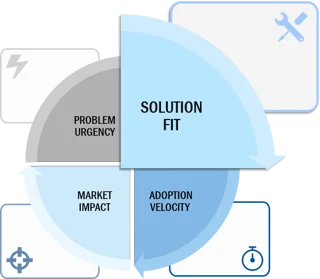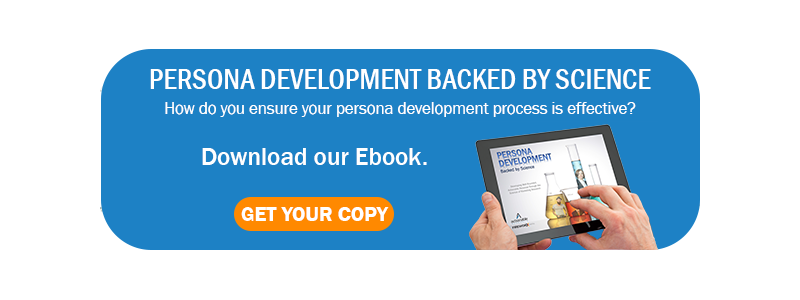The Four Dimensions of Concept Testing
Continuing on our concept testing research discussion – as a reminder, we look at four very important components when testing a new concept in a research setting:
- Problem Urgency
- Solution Fit
- Adoption Velocity
- Market Impact
The Actionable Research Concept Testing Approach examines each of the four dimensions individually, while also keeping in mind that each piece fits together. In order to perform a thorough concept test, we need to understand how the concept performs in each separate dimension as well as the big picture meaning once they are all compiled.
Failing to examine each of these components has consequences which are unique to each dimension. We have already covered the risks you take when glossing over the first dimension of problem urgency; this week we will examine the potential consequences of bypassing the second dimension, solution fit.

Dimension Two: Solution Fit
As we have said before, “Every new product or service – be it a product, idea, new technology – is a solution to some problem.” Solution fit examines how well a concept solves the problem it is intended to solve: Does your concept present a solution in its entirety? Or is it supplemental? Do the costs weigh against the benefits? Does your concept require extra steps, a time commitment, additional products?
Overall the questions we want to examine are, “How well does the concept fit the current problem?” and “Is the solution complete? Is the presented performance profile both satisfactory and believable?”
The answer to each of these questions reveals your concept’s solution fit within the market.
Problem
In dealing with problem urgency, we analyze the problem itself, looking at both the problem and its severity. We further utilize this information in our examination of solution fit.
To show how these two dimensions interact with each other, we will focus on a problem presented in our problem urgency blog – dropped cell phone calls.
Concept Fit
Concept fit examines how well your concept solves a specific, identified problem.
As a people, we are enormously dependent on technology. Because of this, there is nothing more frustrating than when our technology fails us. Though cell phone providers have greatly improved service in an effort to keep up with the changing times, there are still dead zones and we have all experienced the moment when an important call drops. You have to search for a signal, call the person back, hope you can get them again, and keep your fingers crossed that your phone holds the signal long enough to finish the conversation, not to mention making sure they don’t think we hung up on them.
Say a cell phone provider were to introduce the concept of a mobile calling plan with free rollover minutes as a solution to their dropped calls. This concept provides benefits to customers, but does it actually solve the problem of dropped calls? Somewhat, but not really. While it may appeal to customers in that it allows for some compensation for the dropped call time, and may help the company keep some customers, it doesn’t fix the main issue; the pain associated with dropped calls.
A better fit may be to extend the cell phone providers’ network coverage quality by partnering with other providers, reaching previously uncovered areas. Greater network coverage means a decrease in dropped calls, which is a much better fit for the problem.
Notice that the new service is not a total failure. Most of the time, new concepts tested do provide some solace from the pain, but not solving the problem consistent with the main issue leads to product abandonment and stunted adoption cycles.
Complete Solution
In the instance of providing a mobile plan with free rollover minutes, we ask whether this is satisfactory and believable. Would customers be satisfied with this solution? Those who experience dropped calls less frequently (say by virtue of where they are most of the time) and don’t always use all their minutes, or who are concerned about the cost of potential overages may be fully satisfied with this solution; but, if you are really frustrated on a regular basis by the pain associated with calls disappearing for no reason, this probably sounds like a cruel joke. You likely wouldn’t be satisfied at all.
If the provider extends their network coverage quality, it will likely be a more complete solution.
We know from past experience that the more complete the solution and the better the fit, the better the adoption rate and the healthier the demand. Complete solutions to problems help them follow healthy, normal adoption curves, and keep them out of the “Dead Zone” of new product introductions.
 The Dead Zone was described by Geoffrey Moore in a well-written article called “Why Companies Fail” in 1999. It describes what happens when a product expects too much effort from the customer or costs more than its delivered value or gain. Imagine a plot of Pain (commitment, or cost) vs Gain (benefits received). Low pain or effort solutions have low expectations attached to them; as you go up the pain scale, your solution demonstrates that it is not complete, which severely limits its appeal. Note the image also addresses the velocity of adoption as gain increases, the topic of our next article.
The Dead Zone was described by Geoffrey Moore in a well-written article called “Why Companies Fail” in 1999. It describes what happens when a product expects too much effort from the customer or costs more than its delivered value or gain. Imagine a plot of Pain (commitment, or cost) vs Gain (benefits received). Low pain or effort solutions have low expectations attached to them; as you go up the pain scale, your solution demonstrates that it is not complete, which severely limits its appeal. Note the image also addresses the velocity of adoption as gain increases, the topic of our next article.
These nuances impact the way your concept is perceived by your audience and should be thoroughly examined in the concept testing process.
The Big Picture
Finally, we must consider how the dimensions interact with each other. If dropped phone calls are a major problem for your customers, they are likely looking for new solutions urgently. You will want to provide a solution that addresses the problem directly. And if that solution is incomplete, you run the risk of customer defections, regardless of the cost.
The dimensions all intertwine to influence the reception of your concept by your audience and market.
Actionable Concept Testing
At Actionable Research, we have developed a specialized concept testing methodology that focuses on these four critical dimensions of concept testing, and have many years of experience applying them to real-world problems and solutions. If you’re interested in learning more about this approach can be tailored to meet your specific needs, please contact us at info@actionable.com.



